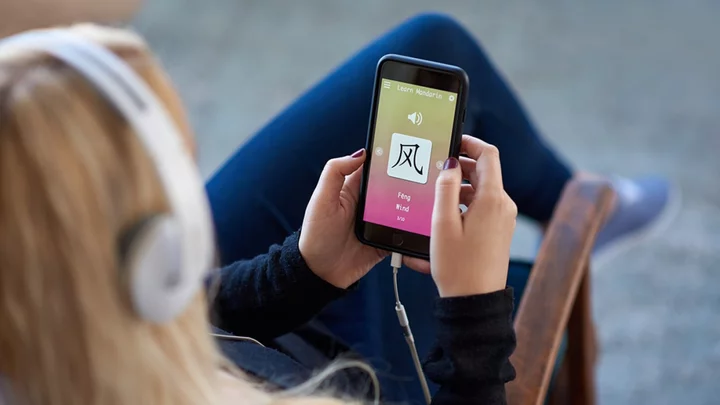What language do you want to learn? Have you already learned a little, or are you starting from scratch? Is your goal to know the language so well that you can speak, hear, read, and write it like a native speaker, or do you have a different goal? Does the language you're learning use a different script? Is it hard for you to make unfamiliar sounds? Answering all these questions is crucial to finding the right apps for learning and practicing a language—yes, apps, plural. If you want to make real progress with a language, whether you're learning for school, travel, family, or personal enrichment, you need a variety of tools.
As with all kinds of education, learning a language takes dedication. Picking the right tools sets you up for success. Read on to learn which apps scored highest in our testing, as well as everything you need to consider when choosing the right language-learning tools for you.
What Is the Best Language Learning Software?
The best app for learning a foreign language depends on your needs and your goals. Apps and online services let you learn at your own pace and in spaces where you're most comfortable. The trick is figuring out what you need to work on at different stages.
Practical Tips for Successful Schooling at HomeWhen you first start out, you might like a program that tells you exactly what to study for an intensive 30 minutes per day. Rosetta Stone and Fluenz are both exceptional at that. Add in a mobile app with more bite-sized content so you can refresh your memory in short bursts. Duolingo is especially good for practicing on the go, as is the study aid Quizlet.
Some language learners find that looking at written language trips up their pronunciation. In that case, you might be better off starting with an audio-focused program, such as Pimsleur or Michel Thomas. Between the two, Pimsleur rates higher in our testing.
If you're already an intermediate or advanced speaker, small group classes or one-on-one conversations with a tutor are excellent options. Lingoda offers one-hour small classes and one-on-one sessions, all conducted over Zoom. Babbel now has similar classes that it sells separately from its app subscription. Between them, we recommend Lingoda more highly. Another place to get human instruction is Rype, which focuses on one-on-one tutoring in 30-minute sessions. Not quite ready to converse? Try Yabla, a site that's flush with videos of native speakers, which can help you acclimate your ear and expand your vocabulary.
Sometimes, you need resources that are specific to the language you're learning. For example, when learning American Sign Language, you really need either a live instructor or videos. Sign It ASL, an online course whose video lessons have the feel of a television show, is extremely effective.
Similarly, for languages with a script that's new to you, it's best to find an app that includes content for teaching reading and writing. In some cases, you might pick up two apps, one that focuses solely on reading and writing and another that teaches speaking and listening. There are plenty of apps that teach only writing for Japanese, Korean, Arabic, Mandarin Chinese, Hindi, and other non-Roman scripts.
How Do You Learn Language Best?
One of the hardest parts about learning a different language is that if you succeed 100% of the time, it's not difficult enough. If it's too easy, you're not learning. It's uncomfortable for many people, but it's another reason you need to explore all your options and language learning apps and resources that match your skill level.
For example, podcasts are a great way to push yourself beyond your comfort zone. Babbel and Duolingo both have good podcasts. If you can understand about 80% of what's being said, that's right where you should be. If you're not into podcasts in the first place, you might get frustrated and give up.
A few apps, including Lingoda, offer placement tests so you can find out which level is the most appropriate place for you to start.
Duolingo is the best free language learning app, offering bite-sized interactive sessions. (Credit: Duolingo)What Is the Best Free Language Learning App?
The best free app for learning a language is Duolingo, hands down. We recommend it enthusiastically, no matter your level or language goals, as it has just about everything. You won't become fluent using only Duolingo, but it is excellent for helping you study and keep up your skills.
It's available as a web app and mobile app, and it works well whether you're a total beginner or already have experience. You can study as many languages as you like on Duolingo. It has more than 30 languages with instruction in English, plus more options if your preferred language of instruction is something else.
If you're not a beginner, Duolingo lets you take a placement test to find the right place to start. It also makes it easy to practice specific skills because it has lessons that focus not only on vocabulary themes (Family, Hobbies) but also on verb tenses and grammatical rules (Past Imperfect, Dative Case).
You can practice exercises in bite-size lessons or explore content for intermediate and advanced speakers, including Stories and podcasts, which are only available for some languages. Duolingo also has some gamification aspects, so you can set a goal for yourself and compete against others. The more you hit your goal, the more bonus points you earn. It's a wonderful app that's totally free. You can support Duolingo by paying for a Plus account, but it's not necessary to get everything this app has to offer.
Is Rosetta Stone Worth the Price?
Rosetta Stone is the most polished language-learning app, with plenty of extras. Among paid programs, it continues to be our top pick, with Fluenz being a close second. Rosetta Stone is often on sale, so you can expect to pay less than the list price to get it. If you and your family members study multiple languages often, the Lifetime membership is a good deal because it gives you access to all of Rosetta Stone's languages for your lifetime for one flat rate (usually you can get it for about $179 on sale).
Rosetta Stone is reliable, accurate, and thorough, with more than 20 languages. We like its rigor, especially for beginners. You know what to do every day, and you can plan to spend about 30 minutes per day completing your lesson. If you follow this routine, Rosetta Stone has enough content to keep you busy for months. Again, you won't become fluent in a language using only Rosetta Stone, but it's superb at getting you started and helping you build a foundation so that you can add more tools to further your learning.
For all these reasons, Rosetta Stone is ideal for anyone who is new to a language and wants to develop a base vocabulary and grammar. It's well-structured, clear, and moves at a deliberate pace. Use Rosetta Stone faithfully for a few months, and you'll learn to speak, read, write, and understand basic words and phrases.
Rosetta Stone uses an immersion teaching style in its interactive software. (Credit: Rosetta Stone)The Best Language Software With a Virtual Teacher
Some learners do best when they have an instructor to guide them. When you're starting with a language, seeing another human being speak it, watching their facial movements, and seeing their smile can make it feel less intimidating. Fluenz gets it. This program uses videos of a teacher to introduce new lessons and review concepts, then follows them up with interactive learning exercises and quizzes. It's as rigorous as Rosetta Stone, but it uses a completely different approach, which some people prefer.
Fluenz has prerecorded video-based lessons with an instructor, plus interactive exercises. (Credit: Fluenz)As Fluenz progresses, the instructor walks you through lessons in not only pronunciation and grammar but culture, too. If you learn best when you see a familiar face, Fluenz is a great program to pick.
Fluenz offers seven language courses: Chinese (Mandarin with Pinyin writing only), French, German, Italian, Portuguese (Brazilian), Latin American Spanish, and European Spanish.
Lingoda's small group classes are limited to five students. (Credit: Lingoda/Zoom/PCMag)The Best App for Group Classes and Speaking Practicing
Lingoda is our top pick for live, video-based group classes designed to get you speaking. With Lingoda, you take a placement test and then commit to a package of classes, which you pay for upfront. Classes take place over Zoom and are limited to five students. One-on-one sessions are also available for a higher per-class cost.
The curriculum and levels used in Lingoda are based on the Common European Framework of Reference for Languages (CEFR). Lingoda offers classes in French, German, Spanish, English, and Business English.
Babbel is the best language learning app for people who like challenging content. (Credit: Babbel)What Is the Most Challenging Language Instruction App?
One app stands out for having lessons that are harder than others: Babbel. While testing this app, we kept a notebook by our side and quickly filled it with words and phrases just to keep up. Not everyone can jump into tough language-learning content, but some people can and like it.
For example, if you're learning a language that's linguistically close to the one you already speak, such as German and Dutch or Spanish and Portuguese, tougher content might be best for you. Additionally, experienced language learners might find Babbel's content just the right speed.
Babbel has 13 languages, assuming your language of instruction is English. You can learn Danish, Dutch, French, German, Indonesian, Italian, Norwegian, Polish, Portuguese, Russian, Spanish, Swedish, and Turkish. There's also a course for learning English, with instruction available in French, German, Italian, Polish, Portuguese, Spanish, and Swedish.
The Best Language App for Intermediate and Advanced Speakers
If you've studied a language before and find that most language learning apps are too easy, you might want to try an app that gives you movies and TV shows in your target language, plus some tools to help you learn the words, phrases, and expressions that are new to you. Two good apps offer this: Yabla and Lingopie (which didn't score high enough to be included in our final list of the 10 best language apps). Both Yabla and Lingopie let you watch videos with the option to show closed captioning in the native language as well as English subtitles. You can look for content from a particular country or region if you're trying to acclimate your ear to a certain dialect or accent.
Yabla helps experienced learners practice listening and comprehension. (Credit: Yabla)What makes them different? Yabla offers six languages: Chinese, French, German, Italian, and Spanish, plus an English program for Spanish speakers. When you sign up, you choose just one language. Lingopie has six languages as well (French, Italian, German, Portuguese, Russian, and Spanish). When you pay for an account, you get access to all the content in all the languages. Yabla has more interactive exercises for practicing the new words you learn, and in terms of genre, it offers both instructional learning videos and entertainment. Lingopie has only entertainment—no lessons on grammar or anything else—and only flashcards for interacting with new words you learn along the way.
The Best Audio-Focused Language Apps
If you're the kind of person who can get immersed in podcasts and audiobooks, you might consider an audio-focused language learning program. Two that stand out are Pimsleur and Michel Thomas. (Michel Thomas did not score high enough to be included in our top ten.) Each is named after the person who created the learning technique used in the program. Both were sold as tapes, then as CDs, and now as apps.
Pimsleur offers audio-focused lessons, plus interactive app content for select languages. (Credit: Pimsleur/PCMag)Pimsleur, named for Dr. Paul Pimsleur, uses a spaced repetition method. In other words, the program uses specific intervals of time between when you first learn a word and when you're asked to recall it, and these intervals are designed for maximum language retention. Each lesson takes about 30 minutes, and you're supposed to do exactly one lesson per day. For select languages, you can find a version of the Pimsleur app with interactive exercises, too.
The method used in the Michel Thomas app is different. Michel Thomas was a polyglot who developed a method of informal teaching. It involves putting people into a classroom and teaching them words that can be used as building blocks. That way, you get to speaking quickly and can mix and match the words you've learned to say in several sentences. When you buy the Michel Thomas program, you hear the recording from one of these classrooms, and you're supposed to play along as if you were there in person.
For learning a language that isn't widely taught, Mango Languages is one of the best places to look. (Credit: Mango Languages)The Best Apps for Hard-to-Find Languages
Most language-learning software is available for Spanish, French, German, Italian, and Portuguese. What do you do if you need to learn Igbo or Ojibwe?
When you're in a bind to find an app for a language you want to learn, there are two sources to try: Transparent Language Online and Mango Languages (which didn't make the cut for this list). Transparent has programs for more than 100 languages. Some of those programs are short, but the company is adding to them over time. Mango Languages is an option if you're stuck, though it's not an app we highly recommend. For some languages, however, it may be your only option.
The Best App for Learning ASL
There are several useful apps for learning American Sign Language, but our clear favorite is Sign It ASL. This app meets the unique challenges of teaching fingerspelling as well as more complex signs, grammar, culture, and etiquette.
Sign It ASL is the best service we've tested for learning American Sign Language. (Credit: Sign It ASL)As you might guess, the content is entirely video-based, using pre-recorded and professionally produced videos. Sign It ASL manages to convey a lot of information in relatively long (up to an hour) video lessons that are entertaining and engaging.
Make Sure Your Apps Are Tough Enough
However you choose to learn a language, stick with it! Don't be afraid to change the app you use as you progress. When an app feels too easy, it's time to stretch yourself in new ways.
If any of the apps in this list sounds right for you, click the link for an in-depth review. If you're looking to learn something other than a language, from coding to sewing, see our roundup of the best online learning services.









